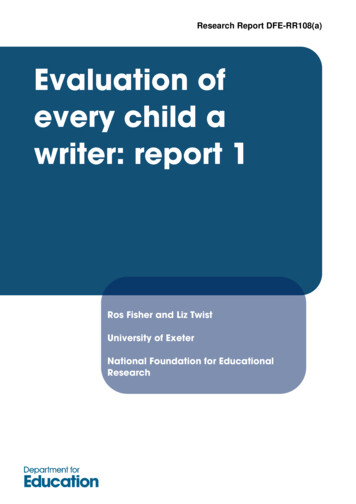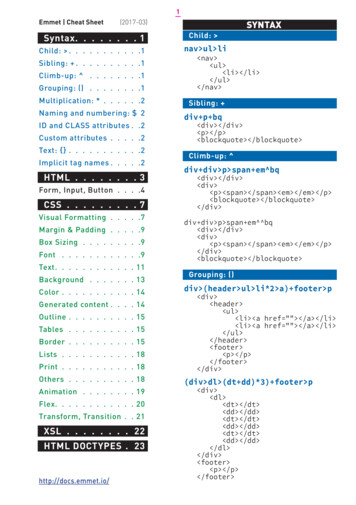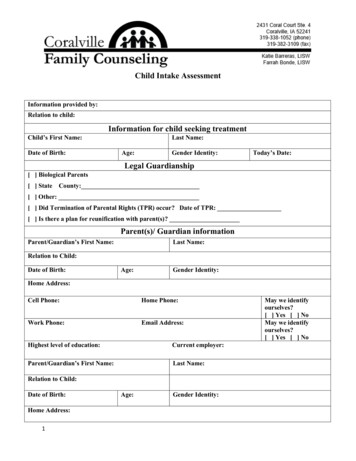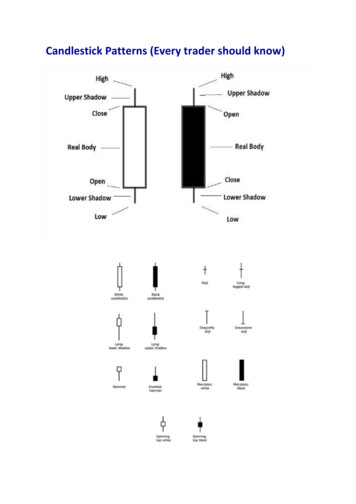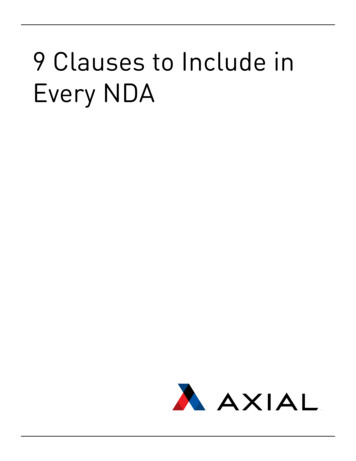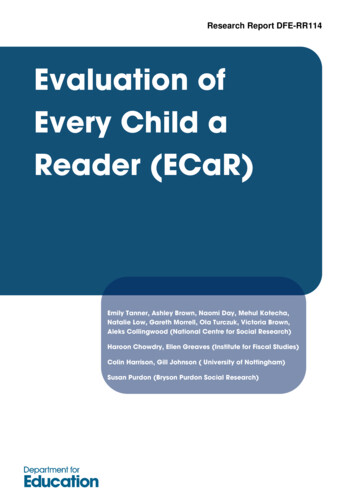
Transcription
Research Report DFE-RR114Evaluation ofEvery Child aReader (ECaR)Emily Tanner, Ashley Brown, Naomi Day, Mehul Kotecha,Natalie Low, Gareth Morrell, Ola Turczuk, Victoria Brown,Aleks Collingwood (National Centre for Social Research)Haroon Chowdry, Ellen Greaves (Institute for Fiscal Studies)Colin Harrison, Gill Johnson ( University of Nottingham)Susan Purdon (Bryson Purdon Social Research)
This research report was commissioned before the new UK Government tookoffice on 11 May 2010. As a result the content may not reflect currentGovernment policy and may make reference to the Department for Children,Schools and Families (DCSF) which has now been replaced by the Departmentfor Education (DFE).The views expressed in this report are the authors’ and do not necessarilyreflect those of the Department for Education.
AcknowledgementsFirst and foremost our thanks go to all of the respondents who gave up their time to takepart in the implementation surveys, qualitative case studies, interviews and completingchild assessments.We would also like to thank colleagues at NatCen and IFS who have made a significantcontribution to the project. At NatCen this includes: Chris Massett, Sonia Shirvington andthe Telephone Unit in the Operations Department, Neil Barton, Elise Yarrow and the PinkTeam in the Operations Department and Erroll Harper in Project Computing.At IFS we would like to thank Alissa Goodman for her contributions to the early stages ofthe project and Barbara Sianesi for expert technical guidance on the impact analysis.We are grateful for the guidance, data and documents provided by Charlotte Madine(National Strategies) and Julia Douetil (Institute of Education).Finally we would like to thank Alasdair Barrett, Angus Hebenton and Jenny Buckland atthe Department for Education (and formerly, the Department for Children, Schools andFamilies) and all the members of the steering group for their active participation in theproject.1
ContentAcknowledgements.1Glossary8Executive Summary .91Introduction .151.11.21.31.3.11.3.21.4Reading standards and policy background. 15Every Child a Reader and Reading Recovery. 17Evidence for Reading Recovery and ECaR. 22The effectiveness of RR and ECaR in the short-term and longer-term. 22The effectiveness of ECaR relative to other interventions . 24The scope and structure of this report. 242Methodology 32.6.4Local Authority and school surveys. 26Qualitative case studies, stakeholder interviews and observations. 27Observation Methodology for Reading Recovery Lessons . 28Impact analysis with administrative data. 29Reading Recovery impact study . 33Teacher assessments. 34Characteristics of RR and comparison pupils . 35Relative impacts of Reading Recovery . 37Value for Money analysis. 37Costs. 37Quantifying the benefits of ECaR . 38Earnings benefits . 40Health benefits. 413Implementing ECaR at Local Authority .2.53.33.3.13.3.23.3.33.3.43.3.53.4Deciding to take part in ECaR . 45Knowledge and experience of ECaR. 45Expected impacts of ECaR. 46Fit with existing Local Authority strategy . 47Early Implementation . 47Consortium set up. 48Selection and recruitment of Teacher Leaders . 49Training of Teacher Leaders . 50Setting-up the Reading Recovery Centre. 55Process for the selection and recruitment of schools. 57Management of ECaR. 59TL role and responsibilities . 59ECaR manager role . 61Consortia communication and working relationships . 63Funding . 65Co-ordinating ECaR with other LA initiatives. 66Training provided to RRTs and schools . 672
3.4.1 Training provided to RRTs. 673.4.2 Support and training provided to other staff . 694Implementing ECaR in Schools .714.1 Joining the programme. 724.1.1 Reasons for involvement . 721. The programme met an identified need within the school . 722. Expected effectiveness of Reading Recovery or ECaR . 723. ‘Fit of programme’ with school priority, other improvement measures or literacy strategy. 734. Pragmatic reasons . 734.1.2 Factors affecting joining the programme . 734.2 Recruiting Key Staff . 754.2.1 Reading Recovery Teachers (RRTs) . 75Selection criteria. 75Advice & guidance for developing selection criteria . 76Fidelity to criteria . 77Recruiting RRTs. 774.2.2 Link teachers . 784.3 Other implementation activities . 794.3.1 Establishing a dedicated space for Reading Recovery . 794.3.2 Acquiring teaching materials . 794.3.3 Adjustments to timetable and staffing. 794.3.4 Engaging school staff . 804.4 Management of ECaR. 804.5 Roles . 814.5.1 The role of the RRT . 824.5.2 The role of the Link teacher . 844.6 Training and Support . 844.6.1 Support, advice and guidance to implement and manage ECaR . 854.6.2 Reading Recovery Professional Development Programme . 87Engaging in theory . 88The daily delivery of Reading Recovery . 89Teaching a pupil and observing others teach . 89Guidance and support. 89Workload . 904.6.3 Training for Link Teachers . 904.6.4 Training for school staff on other interventions . 904.7 A layered approach? . 915Delivering ECaR in Schools roduction. 94Selecting pupils . 94Determining selection criteria . 95Identifying and selecting the pupils. 96Efficacy of criteria and selection processes. 99Engaging parents. 100Delivering RR in schools . 102Model of delivery. 102The role of parents in delivery . 106Fidelity to RR . 1073
5.3.45.3.55.45.4.15.4.25.55.5.15.5.25.6Factors affecting the delivery of RR . 109Discontinuation from RR. 113Delivering other ECaR interventions . 115Types of ECaR interventions. 115Factors affecting the delivery of other ECaR interventions . 117Fidelity to the ECaR model . 119Informing whole school literacy practices . 120Factors affecting the ability of RRTs to influence literacy strategy within schools . 120Monitoring and Evaluation . 1236The Impact of Reading Recovery and pact analysis with administrative data. 126School level analysis . 126Pupil level analysis . 138Descriptive analysis of development phase of Reading Recovery participants . 145Summary . 149Reading Recovery impact study . 150What interventions did pupils receive? . 150Impact . 153Summary . 159Relative impacts of Reading Recovery . 161Profile analysis. 161Results of regression analyses. 162Perceived impacts from the qualitative study . 167Perceived impacts of the programme . 167Key factors affecting pupils and school impact. 169Perceived external impacts . 170Summary . 171Assessment of impact. 171Summary of findings . 172Key messages . 1737Value for Money analysis .1757.17.3Summary of Value for Money (VfM) analysis. 176Calculation of costs. 1798Lessons learned and looking to the future.1978.18.28.38.3.18.3.2Who benefited from ECaR and Reading Recovery? . 197What were the facilitators and challenges to ECaR?. 198Sustainability of and the future of ECaR. 199Views on the future and sustainability of ECaR . 199The future for ECaR?. 200Appendix AReferences.202Appendix BProfile of discontinued and referred ReadingRecovery pupils.206Appendix C4Regression tables for relative impact analysis211
Appendix DSub-group analysis for impact with school leveladministrative data.220Appendix ESub-group analysis for impact with pupil leveladministrative data.223Appendix FAdditional tables for analysis of impact withadministrative data.230Appendix G Additional tables for analysis of impact withadministrative data.235TablesTable 1.1Table 1.2Table 1.3Table 1.4Table 2.1Table 2.2Table 2.3Table 2.4Table 3.1Table 3.2Table 3.3Table 3.4Table 3.5Table 3.6Table 3.7Table 3.8Table 3.9Table 3.10Table 3.11Table 3.12Table 4.1Table 4.2Table 4.3Table 4.4Table 4.5Table 4.6Table 4.7Table 4.8Table 5.1Table 5.2Table 5.3Table 5.4Table 5.5Table 6.1Table 6.2Table 6.3Table 6.4Table 6.5Table 6.6Table 6.75Percentage of pupils achieving the expected level* in Key Stage 1 teacher assessments bypupil characteristics in England. 16Risk Factors that Influence Literacy Skills . 17Reading Recovery implementation information for England 2005 - 2010. 20Profile of children participating in Reading Recovery by year of entry* . 21Methods used in evaluation. 26Background characteristics of RR and comparison pupils in school impact study . 35Foundation Stage Profile scores for RR and comparison pupils compared to all pupils in 200936Empirical strategy for measurement of expected lifetime benefits through each route . 43National Strategies timeline for implementation . 45Goals of ECaR according to ECaR Managers and Teacher Leaders . 46Aspects required for the successful launch of ECaR in LA . 47Methods for recruiting Teacher Leaders. 49Essential criteria for the Teacher Leader role as specified by Institute of Education. 50Usefulness of different aspects of the MA undertaken . 51TL year 1 training . 52Teacher Leaders’ views
This research report was commissioned before the new UK Government took office on 11 May 2010. As a result the content may not reflect current . 1.3.1 The effectiveness of RR and ECaR in the short-term and longer-term.22 1.3.2 The effectiveness of ECaR relative to other interventions .24 1.4 Th
